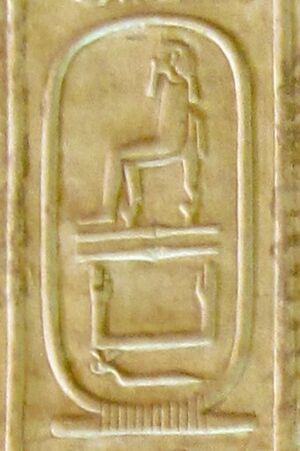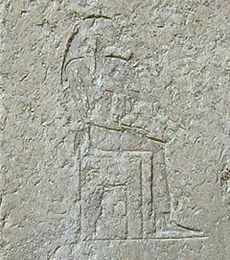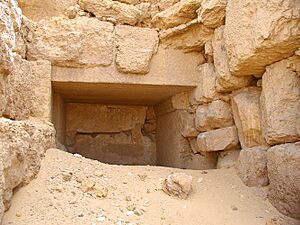Shepseskaf facts for kids
Quick facts for kids Shepseskaf |
|
|---|---|
| Shepseskhaf, Sebercherês, Σεβερχέρης, Severkeris | |

Shepseskaf's cartouche on the Abydos King List
|
|
| Pharaoh | |
| Reign | Duration uncertain, probably four years but possibly up to seven, in the late 26th to mid-25th century BC (fourth dynasty) |
| Predecessor | Menkaure |
| Successor | Userkaf (most probably) or Thamphthis |
| Consort | Uncertain; Khentkaus I or Bunefer |
| Children | Possibly Bunefer (♀), conjecturally Userkaf (♂) |
| Father | Menkaure (uncertain) |
| Mother | Uncertain; Khamerernebty II, Rekhetre, Khentkaus I or Neferhetepes |
| Burial | Mastabat al-Fir'aun |
| Monuments | Completion of the temple complex of Menkaure's pyramid, mastabat al-Fir'aun |
Shepseskaf was an ancient Egyptian pharaoh. He was the sixth and likely the last ruler of the Fourth Dynasty. This was during the Old Kingdom period. His name means "His Ka is noble." The "Ka" was a part of the soul in ancient Egyptian beliefs. He ruled for about four to seven years. This was around 2600 to 2500 BC.
Shepseskaf's family ties are not fully clear. He might have been the son or brother of the previous pharaoh, Menkaure. We also don't know for sure who his mother was. She could have been one of Menkaure's queens. His connection to Userkaf, who likely ruled after him, is also a mystery. Userkaf might have been his son or brother too. Shepseskaf's death probably marked the end of the Fourth Dynasty. The change to the Fifth Dynasty was smooth. It was a gradual shift in the king's power. Around this time, important jobs like vizier (a top advisor) became open to non-royal people. Before, only royal family members could hold these jobs.
During his short rule, Shepseskaf finished Menkaure's pyramid complex. He used mudbricks to complete it. He also built his own tomb in South Saqqara. This tomb is known today as the Mastabat al-Fir'aun. Shepseskaf made some big changes. He decided not to be buried in the Giza necropolis (burial ground). He also chose to build a mastaba instead of a pyramid. A mastaba is a flat-roofed, rectangular tomb. Experts still discuss why he made these choices. Some think it was a power struggle with priests. Others believe it was for practical reasons, like money problems. It's also possible he planned a pyramid, but it was finished as a mastaba after he died. Because his tomb was smaller and his reign was short, his special ceremonies after death were minor. They stopped in the Fifth Dynasty. But they were brought back later by private groups.
Contents
Shepseskaf's Family and Successors
His Royal Family
The exact relationship between Shepseskaf and Menkaure is not completely clear. Many experts believe Shepseskaf was Menkaure's son. This idea comes from a document showing Shepseskaf finished Menkaure's temple. But this document doesn't directly say they were father and son. A king finishing another king's tomb didn't always mean they were related. Some experts think they might have been brothers. If so, Shepseskaf would have been older when he became king. This could explain his short rule. Other ideas suggest Shepseskaf was not royal by birth. He might have become king by marrying Queen Khentkaus I.
We know even less about Shepseskaf's mother. If Menkaure was his father, his mother could have been one of Menkaure's queens. Queen Khamerernebty II or Rekhetre are possibilities. Some think Khentkaus I was his mother. She might also have been the mother of Userkaf, who followed Shepseskaf. The tombs of Shepseskaf and Khentkaus I are very similar. This suggests they had a close relationship. But it's not clear if she was his mother, wife, or daughter.
Queens and Children

We know about Queen Bunefer from her tomb. She had titles that linked her to Shepseskaf. She was called "priestess of King Shepseskaf." This suggests she was his daughter and married another king. Priestesses in a king's death cult were usually his daughters or granddaughters. If this is true, Bunefer is unique. She would be the only queen known to serve in a death cult. Her tomb is near Khentkaus I's tomb. This might mean Khentkaus I was Shepseskaf's wife and Bunefer's mother.
However, some experts disagree. They think Bunefer's titles mean she was Shepseskaf's wife. They believe the mention of his name in her tomb supports this. Bunefer had at least one son. His father was not a king. This suggests Bunefer might have married a non-royal man later.
Princess Khamaat was once thought to be Shepseskaf's daughter. She married a high priest named Ptahshepses. But later findings showed she was actually the daughter of Userkaf. Some experts also think Shepseskaf and Queen Khentkaus I were the parents of Userkaf. Others believe Shepseskaf and Userkaf were brothers.
Shepseskaf's Time as King
How Long Did He Rule?
It's hard to say exactly when Shepseskaf ruled. Experts use different methods to guess dates. These methods don't always agree perfectly. So, his rule is placed somewhere between the late 26th and mid-25th century BC.
Shepseskaf's place in the Fourth Dynasty is also a bit unclear. The Palermo stone, an ancient record, says he became king after Menkaure. But who came after Shepseskaf is less certain. Most evidence suggests Userkaf followed him directly. For example, tombs of officials who served then don't mention any other kings. The Abydos king list also shows Shepseskaf between Menkaure and Userkaf.
However, some old writings tell a different story. A history of Egypt by Manetho from the 3rd century BC mentions a king named "Thampthis" after Shepseskaf. The Turin King List, another ancient record, also has a missing king listed after Shepseskaf. This suggests there might have been another ruler. The Saqqara Tablet also seems to list more Fourth Dynasty kings than we know of. This confusion about who ruled next might mean there was some family trouble at the time.
Shepseskaf's rule probably lasted four years. Some sources say up to seven years. The Turin King List gives him four years. Manetho's history says seven years. Experts think seven years is too long. The unfinished state of his tomb suggests a shorter reign. Four years seems more likely.
What Did He Do?
We know very little about Shepseskaf's daily activities as king. The Palermo stone says he took part in a "going around the Two Lands" event. This was likely part of his coronation. He also had two statues of the god Wepwawet made. The location for his tomb was chosen in his first year. He also probably ordered daily offerings for a shrine.
In his second year, Shepseskaf issued an important decree. It was found in Menkaure's temple. This decree was about finishing Menkaure's temple. It also set up offerings there. And it protected the workers and property of Menkaure's pyramid from taxes.
Menkaure's temple was not finished when he died. It was supposed to be made of granite and limestone. But Shepseskaf had it quickly finished with crude bricks. This material allowed for fast building. Shepseskaf's workers completed the temple's walkways, courts, and storage rooms. The brick walls were covered in yellow mud and painted white.
Some ancient Greek writers like Herodotus also wrote about Shepseskaf. Herodotus called him "Asukhis." He said this king built a brick pyramid. But Herodotus's stories often mix up different kings and times. So, they are not always accurate.
Life at Court
We know about some officials who served Shepseskaf. Their tomb writings mention him. These tombs are mostly in Giza and Saqqara. Many of these writings only mention Shepseskaf briefly. This supports the idea that he had a short reign. Some important officials included Babaef II, a top advisor. There was also Sekhemkare, a son of King Khafre. Ptahshepses I grew up in the royal palace. He later became a priest and married a pharaoh's daughter.
The End of a Dynasty
The idea of dividing Egyptian kings into "dynasties" came from Manetho. He wrote his history for Greek rulers. In reality, the change between dynasties was often smooth. For example, the first king of the Third Dynasty was the son of the last king of the Second Dynasty.
Shepseskaf and Userkaf, the next king, had similar names. Both names talked about the "Ka" of the god Ra. This suggests they were from the same family. Userkaf might have been Shepseskaf's son or brother. Officials' careers didn't stop or change much between the Fourth and Fifth Dynasties. There were no big religious or political problems.
However, ancient Egyptians might have seen a difference. An old story from the Westcar Papyrus tells of King Khufu's family ending. It says a new dynasty would rise. This new dynasty would be founded by three sons of Ra.
Today, experts see a gradual change. The Egyptian government changed. Before, only the royal family held all the power. But during this time, important government jobs opened up to non-royal people. Shepseskaf, Userkaf, and later kings adapted to these changes. They found new ways to show their power. They focused more on the cult of Ra. Ra became a very important state god. This was different from the Fourth Dynasty, which focused more on royal burials.
Shepseskaf's Unique Tomb
Why a Mastaba?
Shepseskaf's tomb is a large mastaba in South Saqqara. The ancient Egyptians called it "Qebeh Shepseskaf." This means "Shepseskaf is pure" or "The cool place of Shepseskaf." Today, it's known as Mastabat al-Fir'aun. This means "bench of the pharaoh" in Arabic. It was first explored in 1858. More detailed work was done in 1924–1925.
Shepseskaf chose to be buried in South Saqqara. This was a change from his ancestors who used Giza. The reason for this is debated. Some think it was a political choice. It brought him closer to the pyramids of Sneferu, an early king. This might have shown his connection to the royal line. Others believe he simply returned to older burial grounds. This would mean no big religious conflicts.
The main reason might have been practical. There wasn't much space left in Giza for another huge pyramid. Also, South Saqqara was close to limestone quarries. This would make building easier. Some experts also guess that kings built their tombs near their palaces. But no Old Kingdom palaces have been found yet.
Shepseskaf chose to build a mastaba instead of a pyramid. This broke a Fourth Dynasty tradition. Several ideas explain this choice. One idea is that he planned a mastaba as a temporary solution. He had to finish Menkaure's pyramid. At the same time, he needed to start his own tomb. He might have intended to turn the mastaba into a pyramid later. The underground parts of his mastaba are like those in royal pyramids. This supports the idea. He might have faced money problems. Or Menkaure's unfinished temple made him more careful.
Another idea is that his tomb was meant to be a step pyramid. But he died early. So, it was finished as a mastaba by his successor or queen. The Palermo stone says his tomb's name was chosen in his first year. This name used a symbol for a pyramid. But later, in an official's tomb, it used a symbol for a mastaba.
Some experts think Shepseskaf chose a mastaba on purpose. Pyramids were strongly linked to the sun god Ra. By building a mastaba, he might have tried to reduce the power of Ra's priests. This could also explain why his name and Userkaf's name don't directly mention Ra. If this is true, it shows a possible religious conflict. This choice suggests that a pyramid was not absolutely necessary for a pharaoh to reach the afterlife.
A different idea is that Shepseskaf might not have had full royal power. He might have been a high official who became king through marriage. He might have been a son of Khentkaus I. He was likely related to the royal family. But he might not have had the same strong claim to the throne as other princes. Facing opponents, he might have chosen a different kind of tomb.
Building His Tomb
The mastaba is rectangular. It measures about 99.6 by 74.4 meters (327 by 244 feet). It is about 18 meters (59 feet) high. Its walls slope at a steep angle. It might have had two steps. Experts consider its size very small compared to earlier pyramids. The mastaba's total volume is only about one-third of Menkaure's pyramid. This might suggest Egypt's economy was declining. It could also mean the king's power was less.
However, some experts disagree. They think the smaller size doesn't mean problems. Instead, it might show a change in religious beliefs. The focus might have shifted from the pyramid itself to the mortuary temple. The temple became the main place for death rituals.
Even with its smaller size, Shepseskaf's tomb was probably not finished when he died. This supports the idea of a short reign. Parts of the temple and the walkway leading to it were quickly finished with mudbrick. This was likely done by a later ruler.
The mastaba's narrow ends were built higher than usual. This made the tomb look like a huge sarcophagus (stone coffin) or a shrine. The outside was covered in white limestone. The bottom part was covered in red granite. The entrance to the underground rooms is on the north side. A long passage goes down to an antechamber. This chamber was protected by three portcullises (heavy gates). There are also storage rooms and the burial chamber. The burial chamber is lined with granite. It has an arched ceiling. Parts of a dark basalt sarcophagus were found there. But the chamber was never finished or used.
The mastaba was surrounded by two mudbrick walls. On the east side was a mortuary temple. It had an offering hall, a false door (a stone carving that looked like a door), and five storage rooms. This temple's design was later used for other kings' temples. A walkway was found leading to the temple. It probably connected to a valley temple, which hasn't been found yet.
Shepseskaf's Legacy
In the Old Kingdom
Like other pharaohs, Shepseskaf had an official cult after his death. This cult was for remembering him and making offerings. But his cult seems to have been quite small. Only three priests for his cult are known. This is much fewer than for kings like Khufu or Menkaure. Also, there's no sign of Shepseskaf's cult after the middle of the Fifth Dynasty. Other kings' cults lasted much longer.
These official cults were supported by farms. These farms provided food and goods for offerings. Because Shepseskaf ruled for a short time, only two such farms are known for him. Khufu, for example, had at least sixty.
However, Shepseskaf's name was still respected. At least seven high officials were named Shepseskafankh. This means "May Shepseskaf live." These officials lived until the reign of Nyuserre Ini. They included a royal doctor, a palace manager, and a priest.
In the Middle Kingdom
There's no sign of Shepseskaf's state-sponsored cult in later periods. But during the Middle Kingdom, a special stone was found at his temple. At that time, the area around his tomb became a burial ground for common people. The stone showed a butcher and his family. They seemed to be running a cult. This cult was not for Shepseskaf himself. It was for the dead buried nearby. People made offerings for their dead. They believed Shepseskaf would help the gods accept these offerings. This cult became a way for the butcher's family to make money.
In the New Kingdom
Shepseskaf's mastaba, like other old royal tombs, fell into ruin. But it was later restored by Prince Khaemwaset. He was a son of King Ramses II. This might have been to get stones for his father's building projects. But he also made sure to do some basic repairs for religious purposes.
Images for kids
-
Statue head at the Boston Museum of Fine Arts believed to depict either Shepseskaf or Menkaure
-
Alabaster statuette of Babaef II, a vizier of Shepseskaf, from his Giza tomb G5230, now in the Kunsthistorisches Museum, Wien





